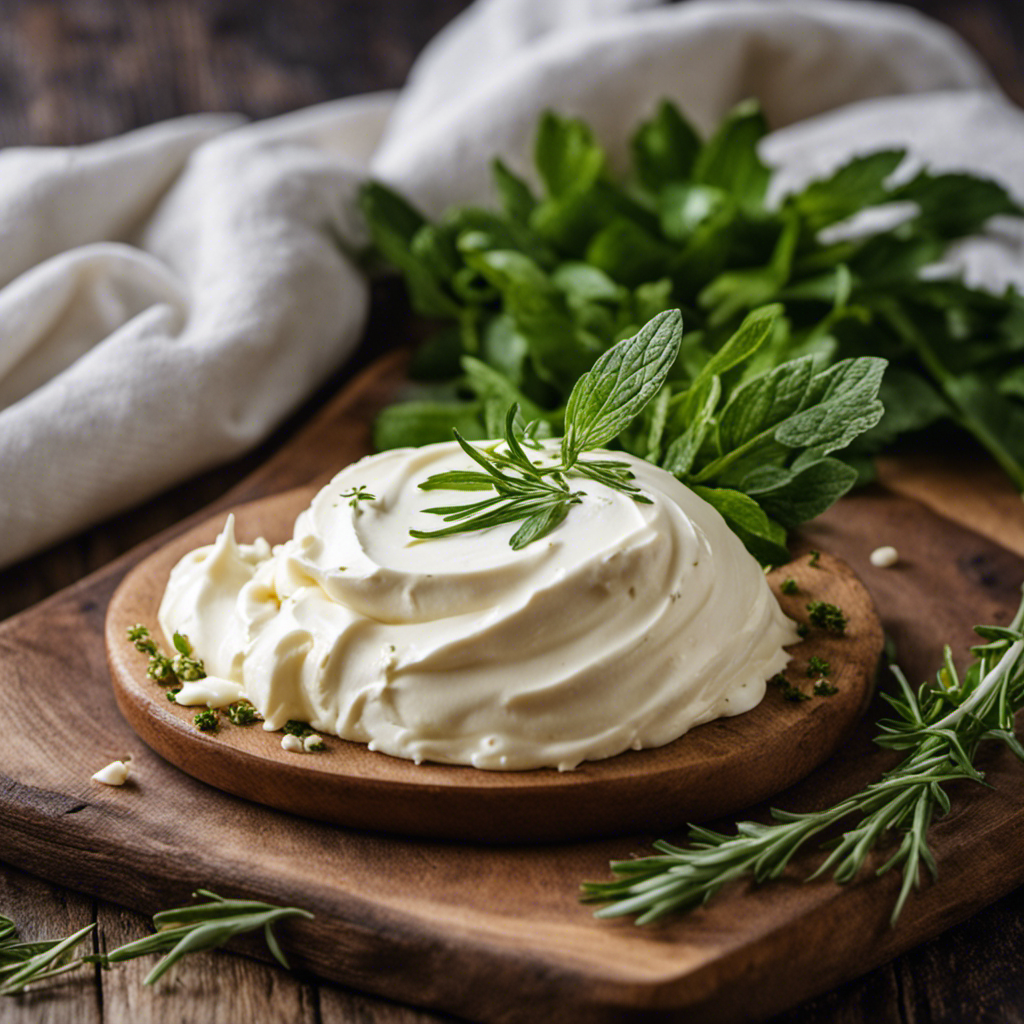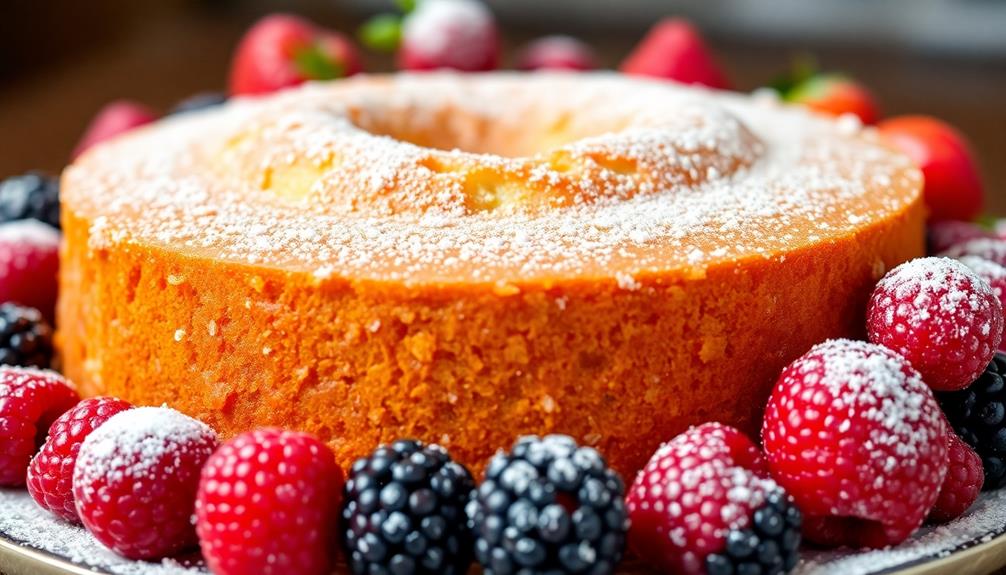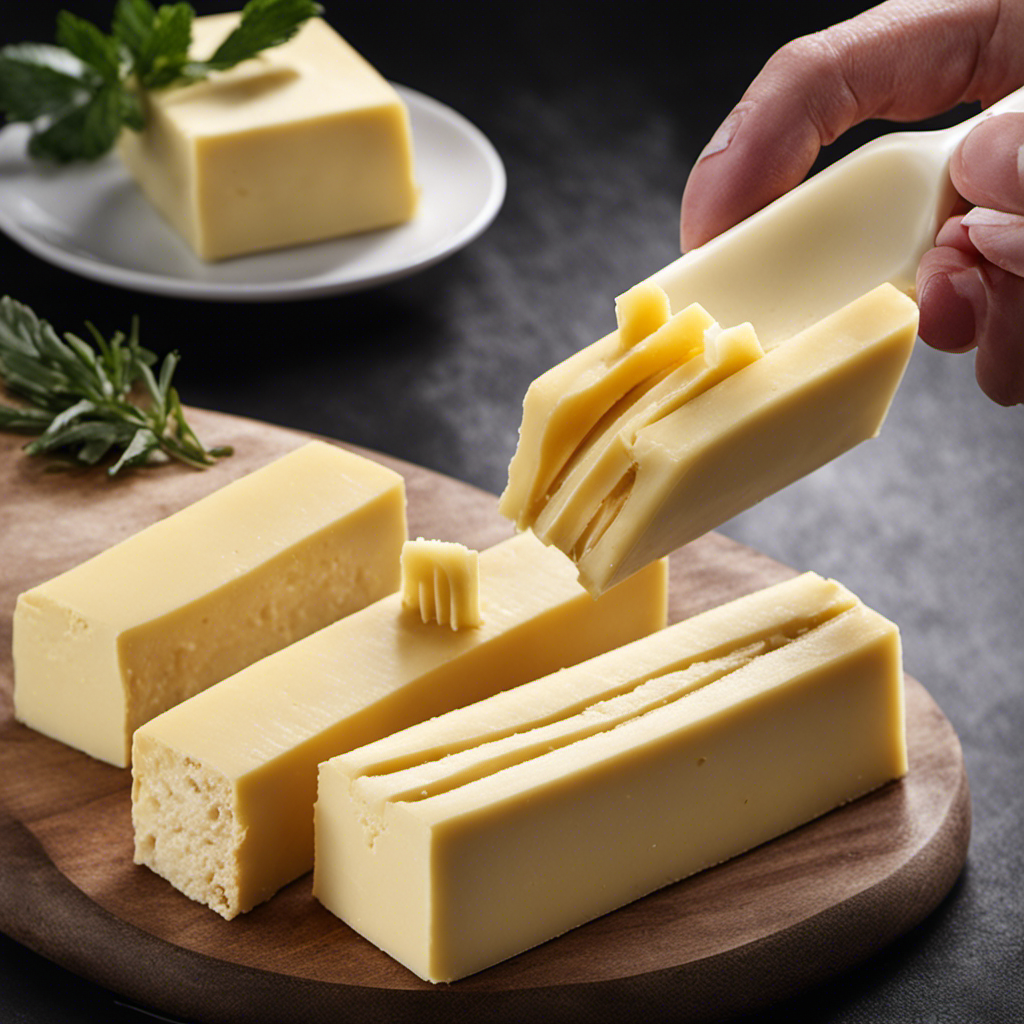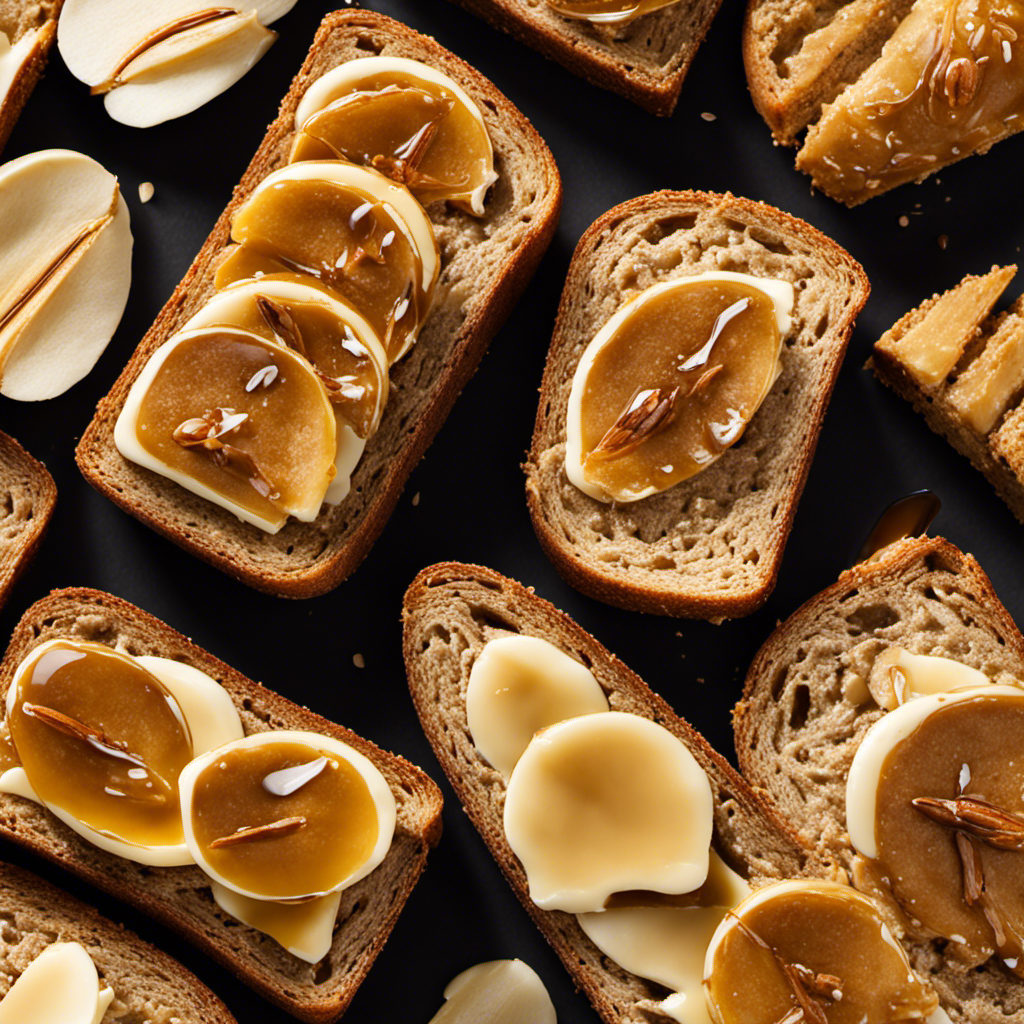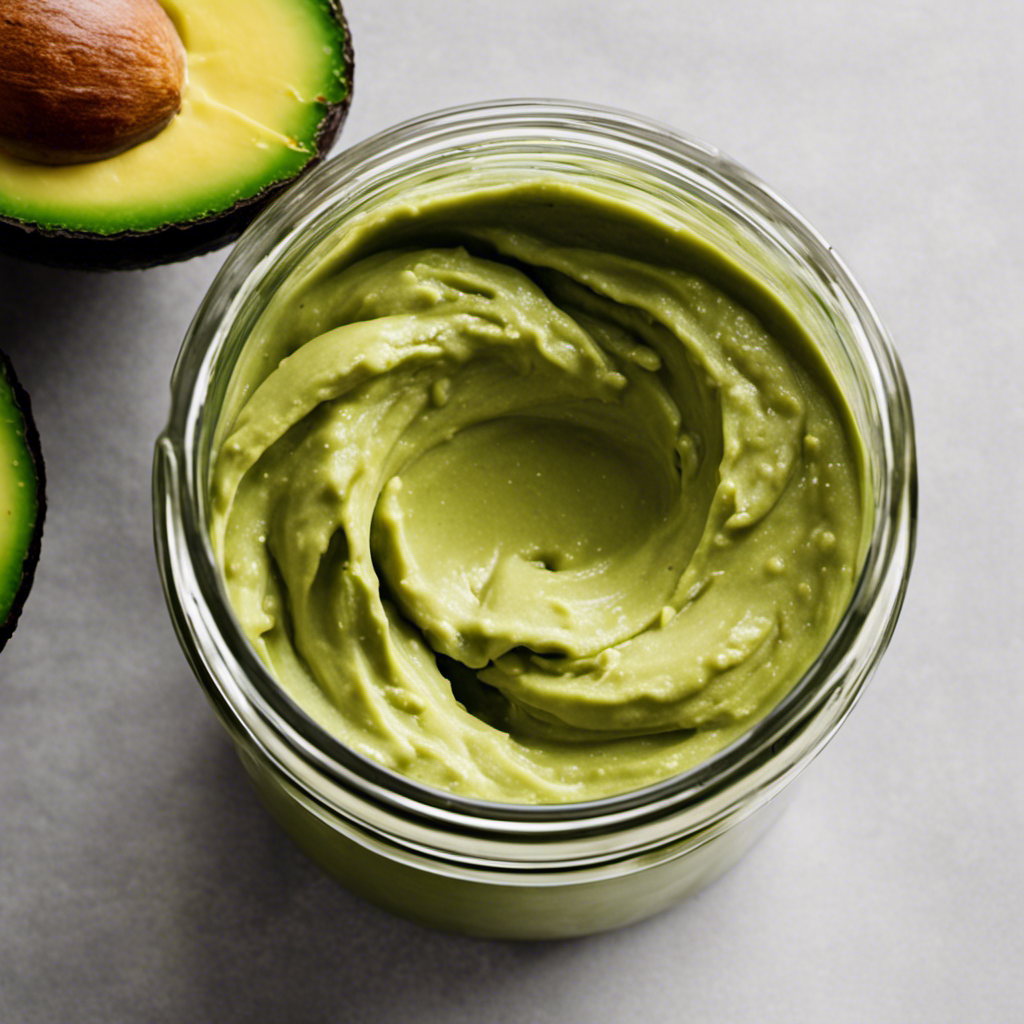Were you aware that crafting whipped butter at home is remarkably simple and can enhance the flavor of any meal it’s paired with? By following a handful of straightforward steps, you can convert ordinary butter into a delicate and airy topping that brings a luxurious element to your dishes.
In this article, I will guide you through the process of selecting the right ingredients, preparing the butter for whipping, achieving the perfect consistency, adding delicious flavors, and storing and using your freshly made whipped butter.
Get ready to take your butter game to the next level!
Key Takeaways
- Using organic ingredients for whipped butter provides benefits in terms of health and environmental sustainability.
- High-quality butter with a higher fat content is preferred for whipping to achieve a smooth and creamy texture.
- Unsalted butter is recommended for whipped butter to allow for better control of the saltiness in the final product.
- It is important to consider sustainable and environmentally friendly butter production methods when selecting butter for whipping.
Selecting the Right Ingredients
To make whipped butter, you’ll need to start by selecting the right ingredients.
Using organic ingredients for whipped butter has many benefits. Organic butter is made from cows that are not given hormones or antibiotics, which means it is healthier and more environmentally friendly. Additionally, organic butter is often produced using sustainable farming practices, making it a better choice for the planet.
When choosing the best quality butter for whipping, there are a few tips to keep in mind. Look for butter that is made from high-quality cream and has a rich, creamy texture. It should also have a yellow, not white, color, indicating that it has a higher fat content. Lastly, opt for unsalted butter, as it allows you to control the amount of salt in your whipped butter.
Preparing the Butter for Whipping
First, soften the butter by leaving it at room temperature for about an hour. This will make it easier to whip and incorporate air into the butter.
Choosing the best type of butter:
- Look for unsalted butter, as it gives you more control over the taste and saltiness of the final product.
- Opt for high-quality butter with a higher fat content, as it will result in a smoother and creamier whipped butter.
- Consider using European-style butter, known for its rich flavor and higher fat content.
- Experiment with flavored butters, such as garlic or herb-infused varieties, to create unique and delicious spreads.
Troubleshooting common whipping issues:
- If the butter is too soft, place it in the refrigerator for a few minutes to firm up before continuing to whip.
- If the butter is too cold and not whipping properly, let it sit at room temperature for a few minutes before continuing to whip.
- If the butter is not incorporating air and remains dense, try increasing the speed of your mixer or adding a splash of liquid, such as milk or cream, to help with aeration.
- If the butter starts to separate or become greasy, it may have been overwhipped. Stop the mixer immediately and salvage the butter by gently folding it back together.
Whipping the Butter to Perfection
Softening the butter at room temperature before whipping it will ensure a smoother and creamier texture. Once the butter has reached the ideal temperature, it’s time to whip it to perfection.
Using an electric mixer, start on low speed and gradually increase to medium-high. The key is to whip the butter until it becomes light and fluffy, with a consistency similar to whipped cream. This usually takes around 2-3 minutes, but keep an eye on it as overwhipping can lead to a greasy texture.
To add flavor to your whipped butter, try incorporating ingredients like honey, herbs, or spices. Simply mix them in after the butter has reached the desired consistency.
These tips will help you achieve the perfect consistency and create delicious flavored whipped butter.
Adding Flavor and Variations
Once the butter has reached the desired consistency, you can easily incorporate various flavors and variations to create a unique and delicious whipped butter.
Here are some ideas to spice up your homemade whipped butter:
-
Infusing herbs into whipped butter: Add a burst of freshness by mixing in finely chopped herbs like basil, dill, or rosemary. This not only adds a delightful aroma but also enhances the taste of your butter.
-
Sweet variations of whipped butter: For a touch of sweetness, try adding honey, maple syrup, or brown sugar to your whipped butter. These sweet variations are perfect for spreading on toast, pancakes, or waffles.
-
Citrus zest: Give your whipped butter a tangy twist by grating the zest of lemon, lime, or orange into it. The citrusy flavor will brighten up any dish you spread it on.
-
Spices and seasonings: Experiment with different spices and seasonings such as cinnamon, nutmeg, garlic powder, or chili flakes. These additions can transform your whipped butter into a versatile condiment that complements a variety of dishes.
Storing and Using Whipped Butter
To properly store and utilize your whipped butter, you should keep it refrigerated in an airtight container. Storing whipped butter is crucial to maintain its freshness and prevent it from spoiling.
The cold temperature of the refrigerator helps to preserve its creamy texture and prevent any bacterial growth. Make sure to place the whipped butter in an airtight container to avoid absorbing any odors from other foods in the fridge.
When it comes to using whipped butter in baking, it adds a delightful richness and lightness to your recipes. It can be used as a substitute for regular butter in cakes, cookies, and pastries.
The whipped texture of the butter helps to incorporate air into the batter, resulting in a lighter and fluffier baked good. So, next time you indulge in baking, don’t forget to reach for your stored whipped butter for that perfect touch of decadence.
Frequently Asked Questions
Can I Use Margarine Instead of Butter for Making Whipped Butter?
Using margarine instead of butter for making whipped butter is possible, but there are pros and cons to consider. Margarine is a suitable alternative, but it may lack the rich flavor of butter and could affect the texture of the final product.
How Long Does It Take to Whip Butter by Hand?
Whipping butter by hand takes time and effort, but the end result is worth it. There are alternatives to hand whipping, such as using an electric mixer. Here are some tips for achieving the perfect whipped butter consistency.
Can I Use a Blender Instead of a Mixer to Whip the Butter?
Using a blender for whipped butter has its pros and cons. The texture can be different compared to using a mixer. It’s important to consider the desired outcome before deciding which method to use.
Is It Possible to Make Whipped Butter With Salted Butter?
Yes, it is possible to make whipped butter with salted butter. However, using unsalted butter allows you to control the amount of salt in the final product. To add flavor, you can mix in herbs, spices, or even honey.
Can I Freeze Whipped Butter for Later Use?
Sure, you can freeze whipped butter for later use! It’s like preserving a creamy cloud of deliciousness. Just make sure to store it in an airtight container and thaw it in the fridge when you’re ready to enjoy.
Conclusion
As I put the final touches on my homemade whipped butter, I couldn’t help but feel a sense of excitement. The anticipation of spreading this smooth and creamy delight on warm toast or melting it over a stack of pancakes was almost too much to bear.
With each scoop, I imagined the burst of flavor and the satisfaction it would bring. The possibilities for this whipped butter were endless, from savory dishes to sweet treats. I couldn’t wait to dive in and explore all the delicious ways I could use it.
So, get ready to elevate your meals with this homemade creation. Your taste buds will thank you!
